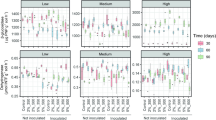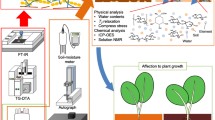Abstract
In recent years, giant reed (Arundo donax L) has received considerable attention as a promising plant for energy production. Giant reed is able to grow in a range of environments, including wetlands and marginal soils, and has shown promise in phytoremediation efforts. A pot experiment was carried out to investigate the ability of giant reed to restore ecosystems of different soils, including bauxite-derived red mud-amended soil and pure red mud (red mud—a waste generated by the Bayer process in the aluminum industry—is strongly alkaline and has a high salt content and electrical conductivity (EC) dominated by sodium). Samples were exposed to high temperatures, which simulate the effects of bushfires. Selected soil properties that were measured included soil dehydrogenase, alkaline phosphatase, urease and catalase activities, soil organic carbon, soil pH, EC, available soil macronutrients NPK, and above- and below-ground plant biomass yield. The results showed that giant reed reduced EC in all autoclaved soils and red mud-contaminated soils by 24–82 %. Significantly, available N was increased, and a slight increase was recorded for available K. The presence of giant reed enhanced the soils’ enzyme activities to recover in all tested autoclaved soils and red mud-contaminated soils; specifically, dehydrogenase activity increased by 262 and 705 % in non-autoclaved and autoclaved soils, respectively, and urease and catalase activities increased by 591 and 385 % in autoclaved soils, respectively. Total bacterial and fungal counts were higher in autoclaved soils than non-autoclaved soils after cultivating giant reed for 12 weeks. Autoclaved soils enabled higher biomass production for giant reed than non-autoclaved soils. These results demonstrate that giant reed is not only able to survive on soil that has lost its microbial community as a result of heat, but can also yield significant amounts of biomass while assisting recovering soil ecosystems after bushfires.





Similar content being viewed by others
References
Spencer DF, Liowa PS, Chan WK, Ksander GG, Getsinger KD (2006) Estimating Arundo donax shoot biomass. Aquat Bot 84:272–276. doi:10.1016/j.aquabot.2005.11.004
Nassi N, Angelini LG, Bonari E (2010) Influence of fertilization and harvest time on fuel quality of giant reed (Arundo donax L.) in central Italy. Eur J Agron 32(3):219–227. doi:10.1016/j.eja.2009.12.001
Lambers H, Chapin III, Pons FSTL (2008) Plant physiological ecology. Springer, New York, p 610
Mirza N, Mahmood Q, Pervez A, Ahmad R, Farooq R, Shah MM, Azim MR (2010) Phytoremediation potential of Arundo donax in arsenic-contaminated synthetic wastewater. Bioresour Technol 101:5815–5819. doi:10.1016/j.biortech.2010.03.012
Pilu R, Bucci A, Badone F, Landoni M (2012) Giant reed (Arundo donax L.): a weed plant or a promising energy crop? Afr J Biotechnol 11(38):9163–9174. doi:10.5897/AJB11.4182
Papazoglou EG, Karantounias GA, Vemmos SN, Bouranis DL (2005) Photosynthesis and growth responses of giant reed (Arundo donax L.) to the heavy metals Cd and Ni. Environ Int 31:2243–2249. doi:10.1016/j.envint.2004.09.022
Alshaal T, Domokos-Szabolcsy É, Márton L, Czakó M, Kátai J, Balogh P, Elhawat N, El-Ramady H, Fári M (2013) Phytoremediation of bauxite-derived red mud by giant reed (Arundo donax L.). Environ Chem Lett doi: 10.1007/s10311-013-0406-6 In press.
Nassi N, Angelini LG, Bonari E (2010) Influence of fertilization and harvest time on fuel quality of giant reed (Arundo donax L.) in central Italy. Eur J Agron 32(3):219–227. doi:10.1016/j.eja.2009.12.001
Spencer DF, Tan W, Liow P-S, Ksander GG, Whitehand LC, Weaver S, Olson J, Newhouser M (2008) Evaluation of glyphosate for managing giant reed (Arundo donax). Invasive Plant Sci Manag 1(3):248–254
Balogh E, Herr JM, Czako M, Marton L (2012) Defective development of male and female gametophytes in Arundo donax L. (POACEAE). Biomass Bioenerg 45:265–269. doi:10.1016/j.biombioe.2012.06.010
Williams CMJ, Biswas TK, Marton L, Czako M (2013) Arundo donax. In: Singh BP (ed) Biofuel Crops: Production, Physiology and Genetics. CABI, Wallingford, p 249
Romanyà J, Khanna PK, Raison RJ (1994) Effects of slash burning on soil phosphorus fractions and sorption and desorption of phosphorus. For Ecol Manag 65:89–103
Gordon C, Amatekpor JK (eds) (1999) The sustainable integrated development of the Volta Basin in Ghana. VBRP, Legon p, 159
Markus G, Matthew L, Ryan T, Craig K, Grace H, Bee G, Alton G, Peter A, Ian D (2010) Chemistry of trace and trace metals in bauxite residues (red mud) from Western Australia. 19th World Congress of Soil Science, Soil Solutions for a Changing World, Brisbane, Australia, 1–6 August 2010. Published on DVD
Li Y, Yetang H, Duojun W, Yongxuan Z (2010) Effect of red mud on the mobility of heavy metals in mining-contaminated soils. Chin J Geochem 29:191–196. doi:10.1007/s11631-010-0191-x
Castaldi P, Melis P, Silvetti M, Deiana P, Garau G (2009) Influence of pea and wheat growth on Pb, Cd, and Zn mobility and soil biological status in a polluted amended soil. Geoderma 151:241–248. doi:10.1016/j.geoderma.2009.04.009
Brunori C, Cremisini C, Massanisso P, Pinto V, Torricelli L (2005) Reuse of a treated red mud bauxite waste: studies on environmental compatibility. J Hazard Mater B117:55–63. doi:10.1016/j.jhazmat.2004.09.010
Snars K, Gilkes R, Hughes J (2002) Effect of bauxite residue (red mud) on the availability of phosphorous in very sandy soils. 17th WCSS, 14–21 August 2002 Thailand. pp 1808.
Martinez-Salgado MM, Gutiérrez-Romero V, Jannsens M, Ortega-Blu R (2010) Biological soil quality indicators: a review. http://www.formatex.info/microbiology2/319-328.pdf. Accessed 13 Apr 2013
Dick R (2000) Soil enzyme stability as an ecosystem indicator. Oregon, United States: http://cfpub.epa.gov/ncer_abstracts. Accessed 8 Jun 2010
Nakatsu CN, Baldwin B, Beasley F, Kourtev P, Konopka A (2005) Soil microbial community responses to additions of organic carbon substrates and heavy metals (Pb and Cr). Appl Environ Microbiol 71:7679–7689. doi:10.1128/AEM.71.12.7679-7689.2005
Marinari S, Liburdi K, Masciandaro G, Ceccanti B, Grego S (2007) Humification-mineralization pyrolytic indices and carbon fractions of soil under organic and conventional management in central Italy. Soil Till Res 92:10–17. doi:10.1016/j.still.2005.12.009
Page AL (Ed) (1982) Methods of soil analysis. Part 2: Chemical and microbiological properties. (2nd ed) Amer. Soc. Agron. In: Soil Sci. Soc. Amer. In, Madison, Wisconsin, USA
Jackson ML (1973) Soil chemical analysis. Prentice Hall of India Pvt, Ltd, New Delhia
Olsen SR, Sommers LE (1982) Phosphorus. In: Page AL, Miller RH, Keeney DR (eds) Methods of Soil Analysis Part 2. Chemical and Microbial Properties, 2nd edn. American Society of Agronomy, Madison, pp 403–430
Allen ON (1953) Experiment in soil bacteriology, Insth edn. Burgess Pulb, USA
Szegi J (1979) Talajmikrobiológiai vizsgálati módszerek. Mezıgazdasági Kiadó, Budapest, pp 250–256
Tabatabai MA (1994) Enzymes. In: Weaver RW, Mickelson SH, Soil Science Society of America (eds) Methods of soil analysis: microbiological and biochemical properties, vol 5, Soil Science Society of America book series. Soil Science Society of America, Madison, pp 755–833
Kandeler E, Gerber H (1988) Short-term assay of soil urease activity using colorimetric determination. Biol Fert Soils 6:68–72
Guwy AJ, Martin SR, Hawkes FR, Hawkes DL (1999) Catalase activity measurements in suspended aerobic biomass and soil samples. Enzyme Microb Technol 25:669–676
Eldor P (ed) (2007) Soil microbiology, ecology, and biochemistry. Academic Press, Chennai
Corstanje R, Schulin R, Lark R (2007) Scale-dependent relationships between soil organic matter and urease activity. Eur J Soil Sci 58(5):1087–1095. doi:10.1111/j.1365-2389.2007.00902.x
Turner B, Haygarth P (2005) Phophatase activity in temperate pasture soils: potential regulation of labile organic phosphorous turnover by phosphodiesterase activity. Sci Total Environ 344:27–36. doi:10.1016/j.scitotenv.2005.02.003
Neary DG, Klopatek CC, Debano LF, Ffolloitt PF (1999) Fire effects on belowground sustainability: a review and synthesis. Forest Ecol Manag 122:51–71
Ketterings QM, Bigham JM, Valerie L (2000) Changes in soil mineralogy and texture caused by slash and burn fires in Sumatra Indonesia. Soil Sci Soc Am J 64:1108–1117
Anderson BH, Magdoff FR (2005) Autoclaving soil samples affects algal-available phosphorus. J Environ Qual 34(6):1958–1963. doi:10.2134/jeq2005.0024
Chromanska U, Deluca TH (2002) Microbial activity and nitrogen mineralization in forest mineral soils following heating: evaluation of post-fire effects. Soil Biol Biochem 34:263–271
Acknowledgments
The work was supported in part by the TAMOP-4.2.2.A-11/1/KONV-2012-0041340 project, and co-financed by the European Union and the European Social Fund. Additional financial support from MOP Biotech Co. Ltd. (Nyíregyháza,Hungary), the Ereky Foundation (Debrecen, Hungary), and the Balassi Institute, Hungarian Scholarship Board (Budapest, Hungary) is also gratefully acknowledged. This research was realized in the frames of TÁMOP 4.2.4. A/2-11-1-2012-0001 National Excellence Program – Elaborating and operating an inland student and researcher personal support system. The project was subsidized by the European Union and co-financed by the European Social Fund. We would like to thank Horvathne Racz Monika and other colleagues at the Microbiological Laboratory of Agricultural Chemistry and Soil Science Institute, Debrecen University, for their help with the soil biochemical measurements. We are also grateful to colleagues at the Central Laboratory for Environmental Studies, Kafr el-Sheikh University, (Kafr el-Sheikh, Egypt) for their help. The authors also acknowledge the handling editor and two anonymous reviewers for their helpful suggestions.
Author information
Authors and Affiliations
Corresponding author
Rights and permissions
About this article
Cite this article
Alshaal, T., Domokos-Szabolcsy, É., Márton, L. et al. Restoring Soil Ecosystems and Biomass Production of Arundo donax L. under Microbial Communities-Depleted Soil. Bioenerg. Res. 7, 268–278 (2014). https://doi.org/10.1007/s12155-013-9369-5
Published:
Issue Date:
DOI: https://doi.org/10.1007/s12155-013-9369-5




